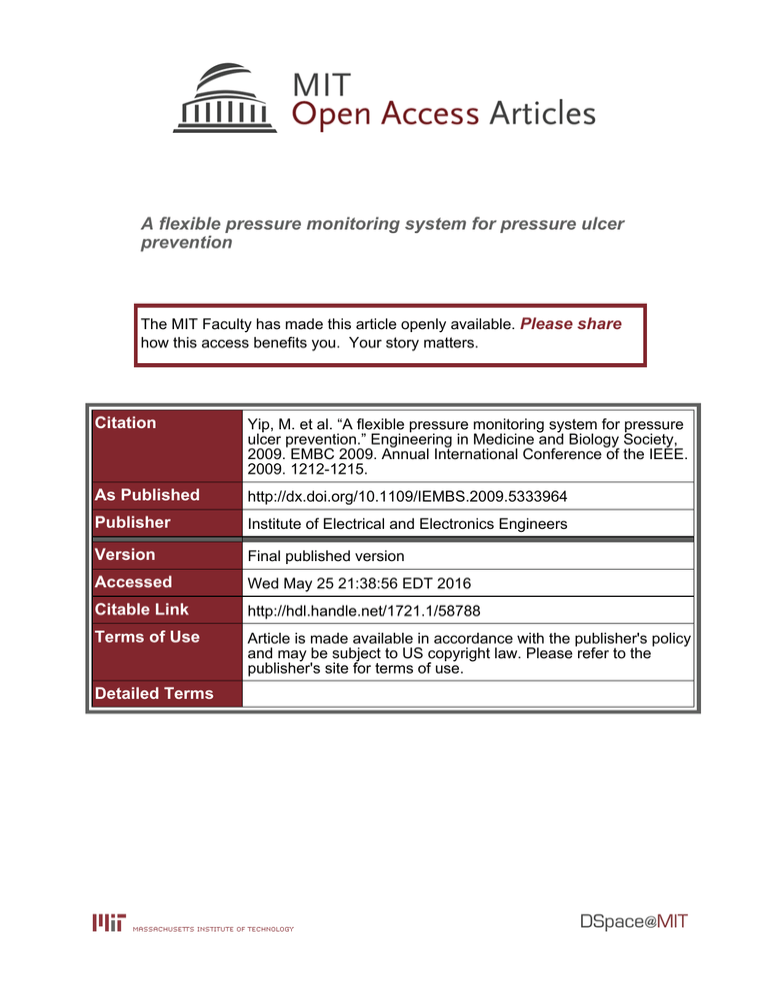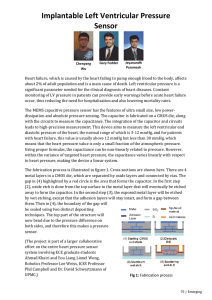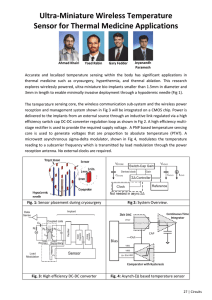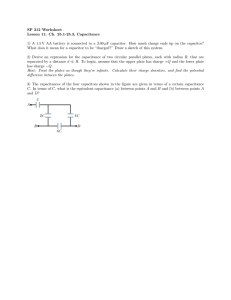A flexible pressure monitoring system for pressure ulcer prevention Please share
advertisement

A flexible pressure monitoring system for pressure ulcer prevention The MIT Faculty has made this article openly available. Please share how this access benefits you. Your story matters. Citation Yip, M. et al. “A flexible pressure monitoring system for pressure ulcer prevention.” Engineering in Medicine and Biology Society, 2009. EMBC 2009. Annual International Conference of the IEEE. 2009. 1212-1215. As Published http://dx.doi.org/10.1109/IEMBS.2009.5333964 Publisher Institute of Electrical and Electronics Engineers Version Final published version Accessed Wed May 25 21:38:56 EDT 2016 Citable Link http://hdl.handle.net/1721.1/58788 Terms of Use Article is made available in accordance with the publisher's policy and may be subject to US copyright law. Please refer to the publisher's site for terms of use. Detailed Terms 31st Annual International Conference of the IEEE EMBS Minneapolis, Minnesota, USA, September 2-6, 2009 A Flexible Pressure Monitoring System for Pressure Ulcer Prevention Marcus Yip, David Da He, Eric Winokur, Amanda Gaudreau Balderrama, Robert Sheridan and Hongshen Ma Abstract— Pressure ulcers are painful sores that arise from prolonged exposure to high pressure points, which restricts blood flow and leads to tissue necrosis. This is a common occurrence among patients with impaired mobility, diabetics and the elderly. In this work, a flexible pressure monitoring system for pressure ulcer prevention has been developed. The prototype consists of 99 capacitive pressure sensors on a 17cm×22-cm sheet which is flexible in two dimensions. Due to its low cost, the sensor sheet can be disconnected from the reusable electronics and be disposed of after use, suitable for a clinical setting. Each sensor has a resolution of better than 2-mmHg and a range of 50-mmHg and offset is calibrated in software. Realtime pressure data is displayed on a computer. A maximum sampling rate of 12-Hz allows for continuous monitoring of pressure points. I. INTRODUCTION Pressure ulcers, also known as pressure sores or bed sores, are localized tissue damage resulting from prolonged exposure (˜ 1 hour) to excess pressure on weight bearing tissue which leads to restricted blood flow and tissue necrosis (cell death) [1], [2], [3]. Pressure ulcers frequently occur in patients with limited mobility, such as spinal cord or head injured patients confined to a bed or a wheelchair, anesthetized patients, and patients wearing casts or prosthetics. In the U.S., pressure ulcers account for an estimated $11 billion in annual health care expenditure lagging only cancer and cardiovascular disease [3]. Pressure ulcers often develop while a patient is hospitalized for an unrelated treatment, and can increase the length of stay by up to five times [2]. It is generally accepted that prevention, rather than treatment, of pressure ulcers can reduce costs and spare patients from unnecessary pain and suffering [4], [5]. Current prevention strategies are either ineffective or too expensive to be widely used. Hospitals mandate that nurses perform manual repositioning of immobile patients every two hours, but this does not guarantee that harmful pressure will be relieved. Static support surfaces like mattress overlays filled with water, gel or foam are commonly used, but patients can still develop pressure ulcers if left unattended for extended periods. Dynamic support surfaces such as rotating beds and mattresses with alternating pressurized air sacs [6] This work was supported by the Center for Integration of Medicine and Innovative Technology, Boston, MA. M. Yip, D. He, E. Winokur, A. Balderrama are with the Department of Electrical Engineering and Computer Science, Massachusetts Institute of Technology, Cambridge, MA 02139 USA (e-mail: yipm@mit.edu; davidhe@mit.edu; ewinokur@mit.edu; adgaud@mit.edu) R. Sheridan is with the Shriners Hospitals for Children Boston and the Massachusetts General Hospital, Boston, MA 02114 USA H. Ma is with the Department of Mechanical Engineering at the University of British Columbia, Vancouver, BC V6T 1Z4 Canada (e-mail: hongma@interchange.ubc.ca) 978-1-4244-3296-7/09/$25.00 ©2009 IEEE can easily exceed $30,000 per unit, making them impractical on a large scale. While the exact conditions for ulcer formation differ across individuals, pressures above arterial pressure of 32-mmHg will restrict blood flow [2]. The key problem is the inability of patients and caregivers to sense pressures applied to various parts of the patient’s body. Commercial pressure mapping systems available from companies such as Tekscan [7] or XSensor [8] are generally very expensive (>$10,000) and are not intended for continuous pressure monitoring applications. To address the lack of low-cost pressure monitoring solutions for hospitals, this paper presents a new cost-effective continuous pressure monitoring system that could be used to determine the magnitude, location and duration of pressure points applied to a patient. The system consists of a flexible pressure sensitive sheet made of a nylon substrate and embedded stainless steel electrodes which is comfortable to lie on and can be placed between the patient and the mattress. Due to its low cost of fabrication (<$50/m2 ), the sheet is disposable and suitable for use in a hospital setting. A reusable electronic interface is used to process and display a real-time pressure map of the patient, providing valuable information to caregivers. II. STRATEGY AND APPROACH A. Capacitive Pressure Sensing A parallel plate capacitor is used as the pressure sensing element, as shown in Fig. 1. When pressure is applied, the dielectric thickness decreases and capacitance increases. By sensing the capacitance, the applied pressure can be extracted. The dielectric of thickness d can be modeled as an elastic material using the spring equation, F = −k∆d, where F is the applied force, k is the spring constant of the dielectric and ∆d is the change in thickness. Assuming that the electrodes are rigid and the electrode area stays constant, a relationship Fig. 1. Parallel plate capacitor model with variable capacitance due to modulation of the dielectric thickness by the applied pressure. 1212 Authorized licensed use limited to: MIT Libraries. Downloaded on February 11, 2010 at 14:55 from IEEE Xplore. Restrictions apply. between pressure P and the relative change in capacitance ∆C/C is derived in (1). ∆C −∆d P ∆C P = , F = −k∆d = → = C d A C dkA B. Capacitor Array (1) To sense pressure over a large area, an array of capacitors is used. The dielectric is sandwiched between rows of electrodes on one side and columns of electrodes on the other side as illustrated on the left of Fig. 2. Parallel plate capacitors are formed wherever two electrodes overlap. (b) (a) Fig. 3. (a) PCB with a MSP430 microcontroller and a AD7147 CDC. (b) Flexible pressure sensor sheet. III. SYSTEM DESIGN A. Material Selection A key functional requirement of the sensor is that it must be soft and flexible to maximize patient comfort. As such, the materials used must allow the entire sensor sheet to be flexible in two dimensions, much like a towel, in order to conform to the patient’s body. 1) Dielectric: Considerations for the dielectric material selection include flexibility, capacitive range, repeatability and cost. In total, over 20 different materials ranging from plastics to fabrics to polymers were evaluated by testing the change in capacitance over a range of applied pressures. The pressure-capacitance curves for different materials are shown in Fig. 4. 2 Capacitance [pF/cm ] 10 A system level block diagram is shown in Fig. 2. A sheet of capacitive pressure sensors flexible in two dimensions is placed under the patient. Capacitance sensing is performed by an Analog Devices AD7147 16-bit capacitanceto-digital converter (CDC). A low power Texas Instruments MSP430F2274 microcontroller controls the measurement sequence. The digitized data is transmitted to a computer via a USB interface using a FT232 chip. A software GUI written in Visual Basic is used to plot the data in real time and post processing is done in Matlab. In order to interface the electronics with the sensor sheet, a USB-powered PCB was designed and is shown in Fig. 3(a). The flexible pressure sensor sheet is shown in Fig. 3(b). 8 Cotton Pressure Sensitive Nylon Neoprene Coated Nylon Lycra/Spandex Silicone 6 4 2 0 0 10 20 30 40 Pressure [mmHg] Fig. 4. Capacitance vs. pressure for various dielectric materials. R A pressure sensitive nylon patch from Wrights was found to have the best combination of characteristics. It is flexible, durable, inexpensive and absolute pressure can be measured beyond 40-mmHg without saturating, which is the highest of all materials tested. In addition, nylon is an engineered fabric which exhibits more repeatable behavior than natural fabrics. 2) Electrode: To maximize patient comfort, only thin and flexible materials were considered for the capacitor electrodes. The capacitor electrodes were made of 4-mils thick stainless steel discs, with the top and bottom electrodes being 10-mm and 13-mm in diameter respectively. The 3-mm difference in diameter was to allow for some alignment tolerance during fabrication. A circular electrode was selected to avoid any protrusions that may cause the patient any discomfort. The discs were connected in rows and columns with 5-mm wide flexible conductive tape as shown on the right of Fig. 5. B. Flexible Sensor Assembly The process for assembling the flexible sensor array is illustrated in Fig. 5. In steps (a) and (b), the electrodes and conductive tape were arranged in columns and rows respectively and adhered to two separate sheets of nylon. The two sheets were sandwiched and flipped together in (c) and a bottom layer of nylon was added in (d) to insulate the bottom electrodes. Nickel plated conductive fabric was added in (e) to serve as a conductive shield, and a final outer layer of nylon was added in (f) to insulate the entire structure. C. Circuit Design Fig. 2. System level block diagram of flexible pressure sensor system. A simplified schematic of the capacitor array and its control circuitry is shown in Fig. 6. The capacitors are 1213 Authorized licensed use limited to: MIT Libraries. Downloaded on February 11, 2010 at 14:55 from IEEE Xplore. Restrictions apply. GND ACSHIELD Control from MSP430 Column Switch Matrix … CIN1 BIAS AD7147 CDC CIN2 CIN4 CIN11 C1,2 C1,3 C1,4 C2,1 C2,2 C2,3 C2,4 C2,9 C3,1 C3,2 C3,3 C3,4 C3,9 C4,1 C4,2 C4,3 C4,4 C4,9 C11,1 C11,2 C11,3 C11,4 C11,9 BIAS BIAS BIAS ROW2 ROW3 ROW4 ROW11 COL9 COL4 COL3 Fig. 6. COL2 COL1 arranged in a 11×9 array, where each unit capacitance Cx,y in row x and column y depends on the pressure applied there. The capacitances are polled and digitized one at a time by the CDC. The CDC senses capacitance by using a 250-kHz excitation signal to dump charge onto the capacitor and a 16bit analog-to-digital converter outputs a value proportional to the capacitance to ground. The columns are multiplexed by using one SN74LVC1G3157 2:1 multiplexer per column. The update rate for each column is programmable from 9 to 36-ms. At its highest rate, the entire array is scanned every 81-ms for a sampling rate of 12-Hz. The remainder of this section will discuss how aggressors such as array parasitics and noise from the environment were mitigated. 1) Array Parasitics: Due to the structure of the capacitor array, parasitic capacitances from the neighboring rows and columns must be shielded. Each CINx pin of the AD7147 chip can be either connected to the 250-kHz excitation signal or an internal low impedance BIAS voltage (VCC /2). The AD7147 chip also has an ACSHIELD output which is a replica of the excitation signal that can be used to shield the capacitor of interest from any parasitics. To digitize the value of capacitor Cx,y , row x is connected to the excitation signal and column y is grounded. All other rows are connected to BIAS and all other columns are connected to ACSHIELD . This is shown in Fig. 6 for C2,3 and the equivalent circuit of the array is shown in Fig. 7. The only capacitance between the excitation and ground is the desired capacitance Cx,y . The parasitic capacitances from all other columns, Cp,col are shielded out. The parasitic capacitances from all other rows, Cp,row are between a low impedance node and ground and do not affect the CDC conversion. Note that there is a large parasitic capacitance from ACSHIELD to BIAS, Cp,aux , but this also does not affect the CDC conversion because of the shield. 2) Noise Shielding: Noise coupled from the environment (e.g. 60-Hz power line noise) must also be minimized. This can be modeled by coupling capacitors above and below the sensor array as shown in Fig. 7. To prevent excessive noise from disturbing the conversion, a flexible nickel plated … … Fig. 5. Fabrication steps for the flexible sensor array. A photograph of the prototype is shown after step (c). CIN3 C1,9 ROW1 C1,1 Schematic of capacitor sensor array. Bottom Top Plane Plane Excitation C p ,col Top Bottom Plane Plane ACSHIELD Cxy C p ,aux BIAS C p ,row Bottom Top Plane Plane Top Bottom Plane Plane Fig. 7. Equivalent circuit showing the selected capacitor Cx,y and the parasitic and coupling capacitances. (a) (b) (c) Fig. 8. (a) Photograph of a hand on the flexible sensor array. (b) Visual Basic GUI displaying the sensed pressures. (c) Pressure map of the hand after Matlab post-processing. conductive fabric driven by ACSHIELD was used to shield the entire array. IV. RESULTS AND DISCUSSION An example pressure mapping of a hand is shown in Fig. 8. The GUI shows the pressure in units of mmHg for each sensor and Matlab post processing is used to generate a pressure map. Table I summarizes the performance of the system compared to existing solutions. Sensor offset exists due to variation in wire length and 1214 Authorized licensed use limited to: MIT Libraries. Downloaded on February 11, 2010 at 14:55 from IEEE Xplore. Restrictions apply. TABLE I C OMPARISON WITH EXISTING SOLUTIONS 0.22 1.29%/hr @ 40-mmHg 0.145 10-80 1.71% N/A N/A 0.5 0-250 N/A 60 5%/hr @ 100-mmHg 0.655 10-200 <1.3% 2.5 x 10 4 capacitive 2-D (but not stretchable) Yes <$50/m2 for disposable sensor sheet <$500 for reusable readout electronics 3-12 7.38%/hr @ 50-mmHg 0.264 0-50 <10% Pressure On 14 min avg max 12 2 10 Pressure Off 1.5 % Drift width, PCB trace mismatch and electrode size variation. These sources of offset lead to varying baseline capacitances for each sensor which must be calibrated out at start-up. Calibration was done in Visual Basic by storing the no-load capacitance and subtracting it from all subsequent conversion results. Cycling tests with pressure on and off were performed for two hours as shown in Fig. 9(a). The measured pressure had a mean of 42-mmHg and a standard deviation of 1.6-mmHg which shows good repeatability. Drift was also measured on multiple sensors by applying 50-mmHg of pressure over the course of one hour. The percentage drift versus time is shown in Fig. 9(b). An average drift of 7.38% was measured which is slightly greater than the drift reported in [5] and [8]. Finally, the effect of sensor hysteresis on the pressurecapacitance curve is illustrated in Fig. 10(a). Multiple sensors were tested and the average hysteresis was determined to be less than 10% of the available range. The time required for a sensor to return to its baseline capacitance after a sensor activation is also plotted in Fig. 10(b). The relaxation time is typically on the order of a few minutes and is a short term effect when compared to the time scale of pressure ulcer formation (hours). Limitations with this version of the prototype include sensor-to-sensor variation and baseline drift. In future versions, periodic re-calibration of individual sensors can mitigate sensor drift due to varying environmental conditions. Furthermore, the power consumption of the electronics can be optimized and wireless capabilities can be added for wheelchair or prosthesis applications. This Work 1 8 6 4 0.5 2 0 0 20 40 60 80 100 0 120 0 10 20 30 Time [min] Time [min] (a) (b) 40 50 60 Fig. 9. (a) Cycling test to characterize repeatability of sensor. (b) Percentage sensor drift over one hour with an applied pressure of 50-mmHg. 2 6000 x 10 4000 3000 Ascend Descend 2000 4 Sensor Activation 5000 CDC Output Scan Frequency [Hz] Drift Spatial Resolution [sensors/cm2 ] Sensor Range [mmHg] Hysteresis electro-pneumatic affixed to seat No N/A [8] XSensor LX Series capacitive 2-D No >$10,000 CDC Output Sensing Technology Flexibility Disposability Cost [7] Tekscan BPMS Model 5330 thin-film 2-D No >$10,000 CDC Output [5] Meffre et al. 1.5 1 0.5 Sensor Relaxation 1000 0 0 10 20 30 40 50 0 0 10 20 30 40 Pressure [mmHg] Time [sec] (a) (b) 50 60 Fig. 10. (a) CDC output vs. pressure with pressure applied and removed, showing hysteresis. (b) The effect of hysteresis on a sensor activation. ACKNOWLEDGMENTS The authors acknowledge CIMIT for funding, and Sangbae Kim and Alex Slocum for valuable guidance. V. CONCLUSION A flexible, inexpensive, continuous time pressure monitoring system for pressure ulcer prevention has been presented. Due to its simple design using inexpensive materials, the sensor sheet is disposable. The low system cost provides hospitals with a viable pressure monitoring solution which can be used ubiquitously. Finally, preliminary plans are being made to validate the prototype on burn victims and infants at Shriners Hospitals for Children in Boston, MA. R EFERENCES [1] B.T. Fay and D. Brienza, ”What is Interface Pressure?” in Proc. of the 22nd Annual EMBS Int. Conf., pp. 2254-2255, Jul. 2000. [2] T.S. Dharmarajan and J.T. Ugalino, ”Pressure ulcers: clinical features and management,” Hospital Physician, pp. 64-71, Mar. 2002. [3] M. Reddy, S.S. Gill and P.A. Rochon, ”Preventing pressure ulcers: a systematic review,” Journal of American Medical Association, vol. 296, no. 8, pp. 974-984, Aug. 2006. [4] G. Bennett, C. Dealey and J. Posnett, ”The cost of pressure ulcers in the UK,” Age and Ageing, vol. 33, no. 3, pp. 230-235, 2004. [5] R. Meffre, C. Gehin and A. Dittmar, ”MAPI: Active interface pressure sensor integrated into a seat,” in Proc. of the 29th Annual EMBS Int. Conf., pp. 1358-1361, Aug. 2007. [6] A. Keogh and C. Dealey, ”Profiling beds versus standard hospital beds: effects on pressure ulcer incidence outcomes,” Journal of Wound Care, vol. 10, no. 2, pp. 15-19, Feb. 2001. [7] Tekscan, Inc., http://www.tekscan.com/medical.html. Accessed Sep. 23, 2008. [8] XSensor Technology Corporation, http://www.xsensor.com. Accessed Sep. 23, 2008. 1215 Authorized licensed use limited to: MIT Libraries. Downloaded on February 11, 2010 at 14:55 from IEEE Xplore. Restrictions apply.



